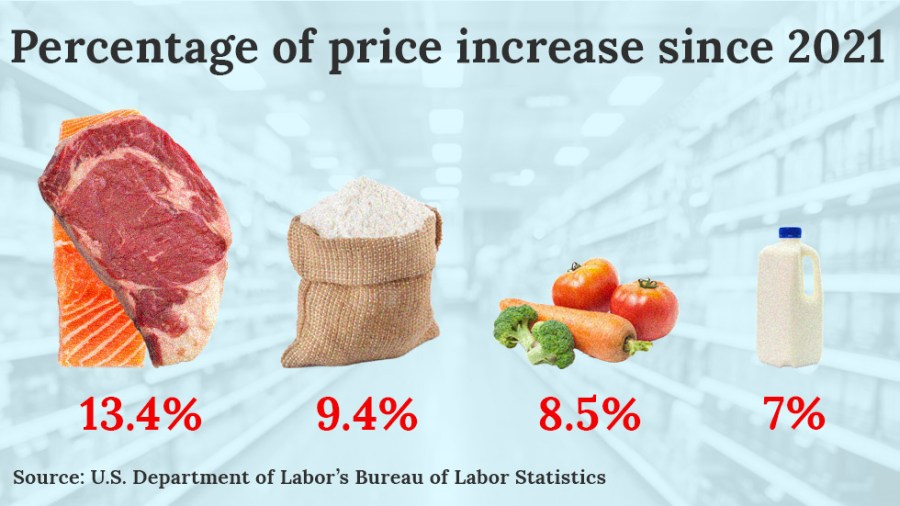Inflation hits the grocery store: Fish, meat up 13.4 percent, 99 cent limes

The rising cost of groceries is putting a pinch on consumers, with food prices jumping up nearly 9 percent in March compared to a year ago.
All U.S. households are suffering from inflation, but the costs are hitting middle-class and low-income families disproportionately.
Food prices relating specifically to domestic food preparation, which affect more middle-class and low-income households, have spiked 10 percent annually, a marked rise that has caught the attention of U.S. food sellers.
“Everything is up. It’s not just produce, we’re seeing it in chicken, eggs, meat. Milk was up this month, but come look at the steak,” a manager at the New York City grocery store chain Union Market, who asked not to be named so as not to get in trouble with his supervisors, said in an interview.
“Look, we just had to mark this one a dollar higher, this one two dollars higher,” the manager said, pointing at different cuts of steak in the refrigerated glass display case, including flank, skirt and rib eye.

Since last year, meat and fish prices have risen 13.4 percent, cereals and bakery products have risen 9.4 percent, dairy is up 7 percent and fruits and vegetables are up 8.5 percent, according to data from the U.S. Department of Labor’s Bureau of Labor Statistics.
Overall inflation, as measured by the consumer price index, is also up 8.5 percent, an annual increase that continues recent trends not seen since the early 1980s.
New York grocer Zan Zan Lwin, an employee of K & Y Fruit and Veggie, said she’s paying particular attention to the price of limes. “It used to be three or four or five for a dollar, and now they’re ninety-nine cents each. Customers are surprised at how expensive they are,” she said.
According to a recent shopping trends analysis from grocery store trade group FMI, consumer demand for groceries hasn’t slackened despite the price hikes.
“Average household spending on food has recently held steady at about $148 per week. While this is down from peak spending of $161 at the height of the pandemic, it is still significantly higher than the average pre-pandemic amount of $113.50 when inflation was much lower,” the FMI analysis said.
Inflation is now the focus of concern for grocery shoppers, with more than half noticing rising prices on their preferred foods, the FMI report went on. Concern varies by income level and is highest among those who make under $75,000 a year, with women more likely to report price concern than men.
To deal with rising prices, many shoppers look for deals, according to FMI. Lower-income shoppers are likely to change what they’re buying, such as switching from fresh to frozen meats.
Grocers area also facing problems that are contributing to a jump in wholesale prices. Logistical bottlenecks aggravated by the coronavirus pandemic remain one cause, but is hardly the only factor.
“The distributors say different things,” said Murat Sonkaya, who works for a fruit and vegetable stand in Brooklyn that sources grapes from Peru and garlic from China, among other imports. “They say it’s gas prices from shipping, they say it’s shortages. With the avocados from Mexico, it’s cartel problems, so that’s different.”
The situation in the U.S. is consistent with price hikes occurring across the globe.
The Food and Agriculture Organization (FAO) of the United Nations recorded a 12.6 percent jump from February in its benchmark food price index, hitting its highest level since first recording data in 2009. The new level represents all-time highs for vegetable oils, cereals and meats, with big increases for sugar and dairy, as well.
The FAO cereal price index jumped 17.1 percent from February, reflecting “a surge in world prices of wheat and coarse grains, largely driven by conflict-related export disruptions from Ukraine and, to a lesser extent, the Russian Federation,” the FAO said.
“The expected loss of exports from the Black Sea region exacerbated the already tight global availability of wheat. With concerns over crop conditions in the United States of America also adding support, world wheat prices rose sharply in March, soaring by 19.7 percent,” the FAO said.
More Americans are feeling worse about their financial prospects, according to the New York Federal Reserve Bank’s March survey of consumer expectations, with 40 percent of respondents saying they feel either much more or slightly less worse off compared to 34 percent the month before.
–Updated on April 13 at 7:56 a.m.
Copyright 2023 Nexstar Media Inc. All rights reserved. This material may not be published, broadcast, rewritten, or redistributed. Regular the hill posts












